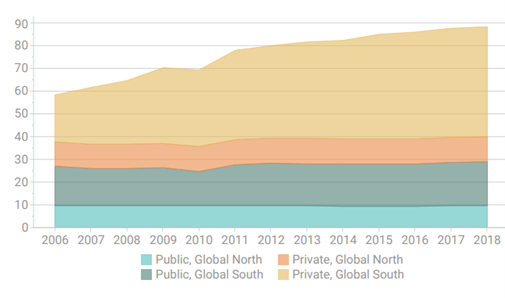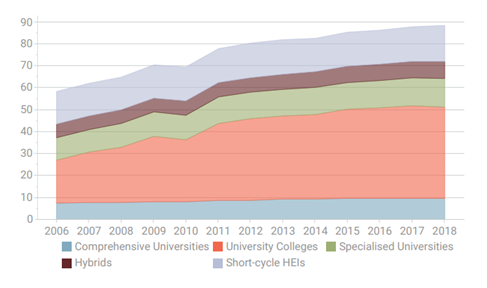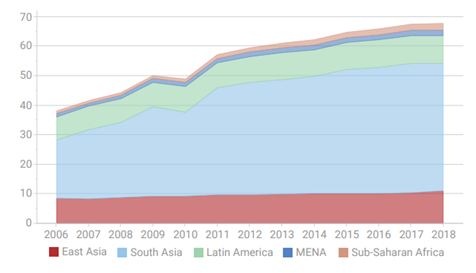By Alex Usher and Jonathan Williams
There are lots of estimates of higher education students around the world, which vary based on whether they include students in more vocational programs (the global total is somewhere in the high 200 millions if you do, and low 200 millions if you don’t). But one thing you won’t see very often is an estimate of the number of higher education institutions. And the reason for that is that pretty simple: big international data collection systems don’t ever ask countries about institutional numbers. And so, to come up with a reasonable estimate of institutional numbers, you must go directly to national sources, which are not always the easiest to work with.
But of course, as a regular reader of this blog, you’ll know that this kind of sleuthing is exactly what my colleague Jonathan Williams has been doing for the past couple of years in order to develop our new publication World Higher Education: Institutions, Students and Funding, which will be released next week (do sign up for the March 31st webinar on release day). And what we found with respect to higher education institutions is quite interesting.
Let’s start with the big picture. How many institutions are there? It depends on how you count them: most obviously on whether a multi-campus institution counts as a single institution or not (for clarity: we choose not to do so). But among the 56 countries included in our survey (which collectively make up close to 95% of all global enrolments), what we found is that the number of institutions increased by 51% between 2006 and 2018, or an increase of about seven institutions every day for 13 years. Essentially, all of this increase occurred in the Global South – that is, Latin America, sub-Saharan Africa, the MENA region, and Asia minus places like Japan, Korea, Taiwan, Singapore, Hong Kong and Israel; in the Global North (that is, the rest of the world) the number of institutions barely changed.
Figure 1: Number of Higher Education Institutions, by Global Super-Region, in Thousands, 2006-2018

Now, broken down by type of ownership – public or private – something on the order of 85-90% of all growth was due to the explosion of private universities in the Global South. Intriguingly, though, this increase has not led to a massive shift in where students are studying: over the period 2006 to 2018, the percentage of students in public institutions decreased, but only from 73% of all enrolments to 70% of all enrolments. These private institutions on the whole are quite small, while public institutions are mostly growing in size.
Figure 2: Number of Higher Education Institutions, by Global Super-Region and Ownership, in Thousands, 2006-2018

We can also look at institutional numbers by type. In Figure 3, institutions are divided into five categories: “comprehensive universities” (i.e. universities with multiple faculties spanning a variety of fields of study), “specialised universities” (i.e. universities which specialise in a field like music, art, communications), “short-cycle institutions” (e.g. community colleges), “hybrids” (i.e. institutions which offer credentials at a number of levels besides baccalaureates) and “university colleges” (i.e. institutions which teach at a university level but don’t offer their own degrees). While growth has occurred across all institutional types, by far the most rapid growth has occurred in the “university college” category, which in 2018 accounted for approximately 47% of all institutions in the world.
Figure 3: Number of Higher Education Institutions, by Type, in Thousands, 2006-2018

Now you may justifiably be asking yourself: where are all these “university colleges” that I’ve never really heard of before? Well, a lot of countries have these kinds of institutions. In parts of Africa, new institutions are often paired with older, more established institutions that are charged with overseeing degree quality and indeed actually issuing degrees. In the Arabian Gulf (among other places) there are lots of branch campuses which are implicitly university colleges. And here in Canada we have had lots of examples over the years, most recently in British Columbia, where until 2006 a number of colleges (such as the institutions now known as Vancouver Island University, University of the Fraser Valley) taught all 4 years of an undergraduate degree but the degrees were issued by UBC, SFU, or Victoria.
The one place where these institutions really predominate is in India (and, to a lesser extent, Pakistan and Bangladesh). As Figure 4 shows, this is where most of the action has been within the Global South. While growth in institutional numbers is by no means limited to South Asia, it is in this region where the overwhelming majority of the changes have occurred.
Figure 4: Number of Higher Education Institutions, by region within the Global South, in Thousands, 2006-2018

For clarity’s sake, something needs to be said about how to classify institutions in India, because it is a bit tricky. There are public institutions and private “unaided” (i.e., tuition-dependent) institutions, each of which enrol about 15 million students. But in between these two is a group of institutions that are privately-owned but nevertheless receive public funds and which educate another 5 million or so students. Internationally, this situation is relatively common (think Japan, Chile or even some Canadian institutions such as McGill), but because countries themselves classify these institutions differently, it is difficult to comes up with a satisfactory global classification for them. As a general rule, we choose to classify them by however countries themselves do so: in the Indian case this means treating the “private aided” colleges as public (as indeed we do McGill in Canada). If, however, we chose to classify these colleges as private, Figure 2 would look even more lopsidedly private than it already does.
That’s it. Don’t forget to sign up for the webinar.

 Tweet this post
Tweet this post

Thanx for this, which is very helpful. Previous estimates of the number of higher education institutions have been very sketchy.
By ‘university’ do you many any institution that awards baccalaureates? Of course others restrict ‘university’ to institutions that award doctorates.